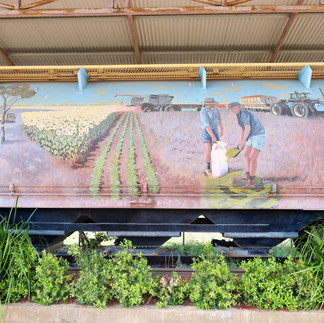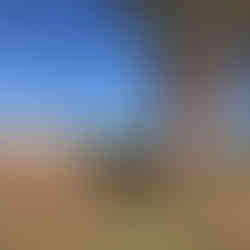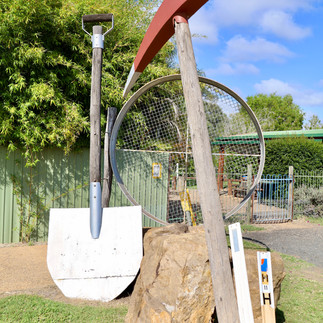CLERMONT - EMERALD ... central Qld
- Woolgoolgaoffroad
- Oct 31, 2022
- 7 min read
I’ve always wanted to explore the Gem fields in Western Queensland around Rubyvale and Sapphire, not only to find a precious stone, but it was all about the history and geology of the area. Having a few days up my sleeve before heading to the gem fields, I decided to explore Clermont and its mining glory and the town's rocky past.

Gold was discovered in the Clermont area back in 1861 by four station hands in some nearby creeks, and with word getting out a gold rush started and the town was born, ‘official’ estimates say nearly 7,400 kg of alluvial gold was found up until 1901.

With so many people in the area Copper was also discovered just to the south of town when a huge wall of the mineral was found by Jack Mollard. Over the next few years, the mine extracted 100,000 tonnes of ore with 22 huge chimneys. A town called Copperfield soon grew with stores, banks, hotels and churches - it was thriving as much as nearby Clermont.
Ten years prior to these mineral finds, a squatter by the name of Jeremiah Rolfe stumbled on the area and set up camp on Mistake Creek and by 1860 he introduced sheep to his station. He thought he settled on the Belyando River, but when he found out his mistake, he aptly named his creek - Mistake.

Wool was another major industry that grew here, but in 1891 the Great Shearers Strike took place in Clermont where shearers were asked to sign a contract that would reduce the power of their union. All hell broke loose and on March 7, massive riots took place in town.

Over the next 50 years, the sheep industry took a huge decline where severe droughts, dingoes and spear grass were near but all killed off the industry. Today there are practically no sheep in the area declining from hundreds of thousands. Today Clermont is all about coal mining and agriculture. To the north of town at Mt McLaren, they have the largest intake of grain deposits in Queensland.

Huge stations that cover thousands of hectares grow an assortment of grain crops to be sent to Mt McLaren, then shipped around Australia. The Blair Athol coal mine was the largest in the southern hemisphere before closing in 2012, today a new open cut has been established NW of Clermont.

Now while you can’t visit these working coal mines, around town there's still plenty to see and do. Places to visit include the heritage-listed rail station built in 1884, the two-story Commercial hotel, and beautiful railway wagon mural art plus there's the heritage museum, the piano in the tree from the devastating 1916 flood where a 16-foot wall of water wiped the town out plus the last remaining copper chimney and old store, south at Copperfield.
HEADING TO THE GEMFIELDS
My route down to the Gem fields would take me out past the beautiful Theresa Creek Dam where you can camp and use the dam to your heart's content, then head into Rubyvale the back way. For the good part of the way, the road was sealed with views across the plains with what looked like weathered-down volcanic peaks. It wasn’t until I found a roadside sign saying that this area had at least 80 active volcanoes from Clermont to the Gemfields over 100 million years ago.

The Gemfields are the largest sapphire fields in the southern hemisphere all created from ancient volcanic activity. Basically, as the earth's crust shifted it let the hot spots under the surface explode spewing out basaltic ash and lava, there are volcanic peaks everywhere !!

Underground, sapphires and zircons that had formed deep under the crust, blasted out in the volcanic ash. Over the next million years or so, layers of earth material covered these precious gems to what we have today.

It was in 1873 when Mr John Richardson found the first sapphire deposits while surveying the area and over the years to follow, thousands of hopeful people moved to the area staking claims all across the area. When gold and copper prices dropped north at Clermont, miners headed to these fields hoping to find their fortune.

Sly grog hotels, grocery stores and shanty towns soon appeared across the valleys. In 1908 at the height of the first boom a small camp was proclaimed as Rubyvale, the same day as the school opened. Miners dug deep shafts with connecting tunnels looking for ‘the seam’ that held the precious stones, and still today most of these tunnels exist underground. When the second boom was on, Australia was producing over 70% of the world's Sapphires, from the surrounding fields.
At Rubyvale, the best thing to do is the Miners Heritage mine tour that was once Australia’s largest underground sapphire mine. You'll see old mine gear, walk in a maze of tunnels, see raw Sapphires still in the wall, and look into 100-year-old shafts - all on the guided tour.

These days it's a major tourist attraction where you can venture downstairs in the old working mine, seeing how and where the gems are found in the old beds, they explain techniques like how the dirt goes to the top, how it gets sorted plus how mining started in the area.
Around Rubyvale, there are plenty of places where you can start digging ( just need to apply for a QLD fossicking permit ) and even camp for free out on the gem fields.

Different areas have different levels where the gems are found but just make sure you don’t dig in an existing mine claim, these are highly recognisable by 4 white posts with corresponding numbers on them, normally in a 30 x 30 m square.

Online and on the town's notice boards there's a stack of info on where you can dig, the boundaries and how deep the gems are usually found. My tip here is to take a pic with your phone for reference out in the scrub as it can get confusing just where you can and can't go.

There's also a mining heritage trail that you can follow through the Gem fields with interactive speaker posts at significant points, which makes for a good couple of hours driving around past the unique bush mining 'shacks'.
Some are pretty unique in the way they have been built, and others have a lot to be desired, out here it's use what you can and just make things work for survival.

Rubyvale is like a little village and a hive of activity with a general store, jewellery shops, a pub and the normal tourist fancy things. But further down the road at Sapphire, it's a bit more working class without the flashy tourist trail. West of town there's fossicking and camping at Big Bessie which was a major gem field back in the day.
It’s actually pretty daunting driving around and exploring the gem fields because of the amount of formal and informal tracks that crisscross through the bush, so if in doubt either ask if you see someone or head off somewhere else if it doesn’t feel right.

HEADING TO EMERALD
After a few days here it was time to head away and across to Emerald, about 40 minutes to the east. If you really want more digging action there's always the opportunity to head further south to Anakie or the Willows Gemfields, both with their own characteristic charm.

Emerald is a beautiful place, where on the outside it comes across as just another outback working town. Today is a thriving rural centre with nearly everything a big city has, but it dates back to 1845 when explorer Leichhardt set up in the area. The tree that he marked with ‘dig’ inscribed into the back is now in Queenslands museum in Brisbane. Gold and copper were found in the area but that was short-lived until the railway came to town in 1879.

Move to today and there's wealth in cropping, nearby coal mines of the Bowen Basin mining group and one of northern Australia’s largest citrus farms. For the tourists, there's plenty to see and do in the area.

Right in the heart of town, there's the beautiful national trust-listed railway station dating back to 1900 that has been fully restored back to its former glory.
A visit to the information centre will have you wandering around pioneer buildings, walking the mosaic pathway celebrating 100 years plus admiring the world's biggest Vincent van Gogh sunflower painting. This thing is enormous, standing on its own superstructure easel at 25 metres high, you'll seriously need to stand way back to view the super painting !.

Out of town, there's the very impressive Lake Maraboon which was built in 1968 and finished four years later in 1972. It's Queensland's second largest dam, three times larger than Sydney Harbour when full, has an 800-metre long wall when full covers an impressive 37,000 acres and means ‘where the black ducks fly.

The dam is well stocked with Nth Qld fish and red-claw, it's boat-friendly and supplies over 300 irrigators downstream for their water. Today the dam was sitting at 23%, but because it's a relatively shallow dam there's water as far as your eye can see, and from the viewing area you can see where the dam would fill when totally full.
My trip through this area was unexpectedly jam-packed full of surprises once I started digging, and it definitely won’t be my last to these central Queensland hotspots. I think I’ve only just scratched the surface here.

FAST FACTS
WHERE
Emerald, Clermont and out the Gem fields are a solid 950 km NW of Brisbane by car. These destinations can be done all on sealed roads.
WHAT TO SEE AND DO
Clermont has amazing mining history, the Gem Fields are re-known worldwide for their precious stones, and Emerald has both natural and man-made attractions waiting to be discovered. All places have relevant services and camping options plus there are local attractions to enjoy.
OTHER INFO
My starting point with be the relevant towns tourist information centres online, or in town once you get there. For a fossicking licence, these need to be bought online on the QLD government website.





















































Comments